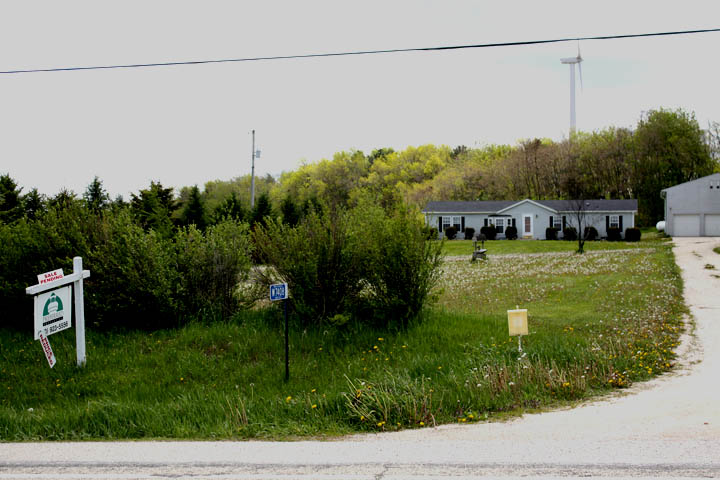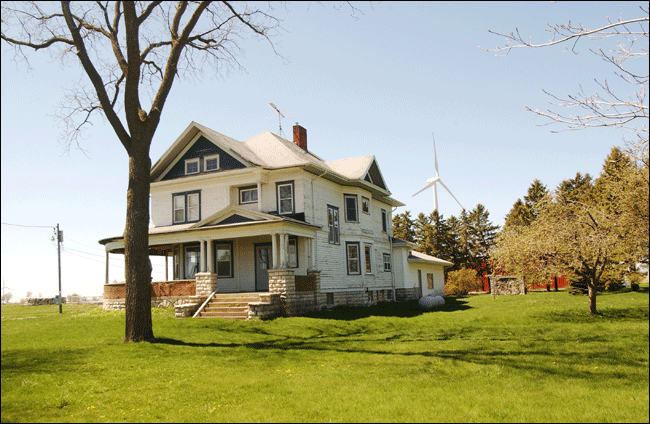Entries in We Energies (16)
1/18/11 Hot off the Press! Walker's Bill AND But they said it would be only as loud as a refrigerator AND Wind developers: Do they have what it takes to take what you have? Unless Walker's bill passes, the answer is yes AND from our "What the ---" department: Anti-local government wind lobbyist spins Walker bill as anti-local government
Click on the images above to hear the sound of wind turbines in DeKalb County, IL. The top video was recorded yesterday.
Who is losing sleep because of wind turbine noise? The video above was shot from the home of this family.

This is the family, these are the children now living with the noise from poorly sited industrial turbines. You can read about what has happened to their lives since the turbines went on line by CLICKING HERE to visit their website
Note from the BPWI research nerd: While the 1800 foot setback from property lines proposed in Governor Walker's bill will not solve the the problem of wind turbine noise or shadow flicker it will provide much more protection for Wisconsin residents than the PSC's recent adoption of wind-developer-friendly rules, and make it more difficult for developers to site projects without the consent of the people who will be living with the turbines.
This is why wind developers and national and local lobbyists are pushing hard to make sure this bill does not pass.
WHAT YOU CAN DO RIGHT NOW TO PROTECT PROPERTY RIGHTS IN THE BADGER STATE
Please support Governor Walker's effort to increase industrial wind turbine setbacks to 1800 feet from from property lines. This setback will protect your right to build and plant trees on your land.
Current PSC rules allow turbines to be as close as 410 feet from your property line. They also prohibit you from building anything within 1250 feet of a wind turbine located on your neighbor's property. This turns portions of your land into a no-build and no-tree zone even though the turbine is not on your property. Some have long argued that this constitutes a 'taking' of your property.
Without the wind company's permission, one family in the We Energies Blue Sky Green Field wind project in Fond du Lac County can't build a long-planned attached garage onto their home because of wind turbines on their neighbor's farmland. Families who intended to build on their own land or add onto their homes are not be able to do so because of turbines located just 400 feet from their property lines.
A wind developer prospecting in Rock County expressed his feelings about impact to non participating property owners this way: "There are always winners and losers in any project."
Better Plan encourages you to contact Governor Walker's office to thank him for including a more protective setback in this proposed bill than that created by the Public Service Commission. We also urge you to contact your senator and representative right away to ask them to support this important bill.
CONTACT Governor Scott Walker govgeneral@wisconsin.gov
115 East Capitol
Madison WI 53702
(608) 266-1212CONTACT Legislators
Who Are My Legislators? To find out, CLICK HERE
From our "What the ---? department:

“This unreasonable proposal is a steamroller driven by anti-wind special interests, like realtors, bent on denying local governments the ability to decide what’s in their best interests,” said Vickerman.-
SOURCE: Alternative Energy Press Releases
Michael Vickerman worked hard to help pass a bill which stipped all local government in our state of the power to enact ordinances regulating wind siting in their communities and also overturned local wind ordinances. He is a PSC appointed member of Wisconsin's Wind Siting Council and in 2010 was a registered and paid lobbyist for RENEW Wisconsin whose clients include Alliant Energy, ATC, We Energies, MG&E, North American Hydro, WPPI, and major wind developers such as Invenergy, EnXco, Horizon Wind, Emerging Energies and other wind developers with projects pending in our state. [SOURCE]-
UPDATE: Although registered as a lobbyist in the past, Mr. Vickerman's name does not appear on the most recent list of 2011 lobbyists for RENEW Wisconsin. CLICK HERE FOR SOURCE
Here's the most recent press release written by Michael Vickerman
RENEW Wisconsin: Walker’s wind siting proposal strips local control
1/18/2011
More information
Michael Vickerman
Executive Director
608.255.4044
mvickerman@renewwisconsin.org
Mandating by statute an extreme setback distance for commercial wind turbines, Governor Scott Walker’s wind siting proposal would strip local governments of their ability to negotiate lesser setback distances with wind developers, according to RENEW Wisconsin, a statewide renewable energy advocacy group.
Walker’s proposal would require a setback distance between a turbine and neighboring property line of 1,800 feet, which can be shortened only by an agreement between the project owner and owners of adjoining properties, entirely bypassing towns and counties.
Walker’s proposal would eliminate the ability of local governments to attract wind developments that would generate revenues in lieu of taxes to help buffer the expected cuts to local governments in the upcoming state budget.
A story in the Fond du Lac Reporter on January 12 quoted town and county officials as saying the wind project revenue helped save on property taxes by filling the gap between rising municipal expenses and declining state-paid shared revenue dollars.
“We’ve seen five towns in Fond du Lac and Dodge counties enter into joint development agreements specifying reasonable setback distances because town officials wanted to capture the economic benefits of hosting wind projects larger than 50 megawatts,” Vickerman said.
The statewide siting rule, approved by the Public Service Commission (PSC) and set to take effect March 1, preserved local government authority to specify less restrictive conditions. “This unreasonable proposal is a steamroller driven by anti-wind special interests, like realtors, bent on denying local governments the ability to decide what’s in their best interests,” said Vickerman.SOURCE: http://wispolitics.com/index.iml?Article=223600
How big are those blades again? CLICK ON the image below to see turbine blades being transported by train.
EXTRA CREDIT READING:
Where is Ex-Governor Doyle working now?
AND.... Extra credit question: WHY ARE GOLDWIND EMPLOYEES DANCING IN A CHINESE WIND FARM? COULD IT BE THE U.S. STIMULUS DOLLARS? To read more about it, CLICK HERE
10/5/10 Big Worries in St. Croix County about proposed project AND Chasing down the myth of the 'well funded' anti-wind groups AND Chapters 3,470 of "Wind Developers Behaving Badly" --Wind Goliath stomps on and laughs off local government law.
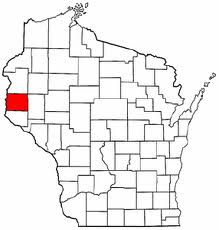
NOTE FROM THE BPWI RESEARCH NERD: The turbines mentioned in the story below will be close to 500 feet tall if blade tip length is included. The turbine height here is for hub height of the tower itself, minus the blades. Scroll down to the previous post to see a 500 foot turbine in a project now being constructed in the Town of Glenmore, Brown County by the same company proposing this project in St. Croix county.
RESIDENTS VOICING CONCERNS OVER WIND TURBINE PROJECT IN ST. CROIX COUNTY
SOURCE: WQOW TV, www.wqow.com
October 4 2010
Town of Forest (WQOW) – Much of our countryside is filled with cornfields and forests. Now, imagine the landscape dotted with wind turbines. That’s the picture being painted in one town and many people there are hot about it.
A Wisconsin energy company wants to build almost 40 wind turbines in the Town of Forest, that’s in St. Croix County. Each turbine would be more than 325 feet tall. Emerging Energy, LLC. has been exploring the idea for a few years and then in August, the town board approved the deal.
“We don’t feel there was a lot of information given at the township level to the citizens,” says Matt Radintz, a concerned resident.
That isn’t their only concern.
“We’re concerned about some of the effects of the wind turbines in our area,” says Radintz.
They’re talking about the shadows created – along with noise.
“We did hear the low frequency hum, it was a constant hum and with the turbines also a whoosh, it actually sounded like a jet plane going over head constantly, but you get the pulsating whoosh,” a woman who had recently visited a wind farm in Iowa told the crowd Sunday night.
The Town of Forest isn’t zoned, which is why residents feel their community was targeted for the project. The state is working on coming up with unified rules to address wind turbines, but because the project is already approved the town would be exempt.
“There are specific regulations right now that have yet to be determined at the state level, that will determine the setbacks and we feel that the reason this got pushed through is to get underneath those,” says Radintz.
Since the agreement was made, the group has held several meetings and hopes a petition can persuade the board to rethink the plan at least until there’s more information available.
“We want them to take a step back look at all the issues that we’re concerned about and put it on hold until we have some answers,” says Radintz.
WQOW News 18 spoke with an employee from Emerging Energy Monday. Bill Rakocy says the agreement in August was just the next step in getting the turbines built. The plan is to have them built no later than 2013. Rakocy says there were a couple of hearings held in 2008 and again this year about the project.
The project is part of an effort to have ten percent of the state’s energy come from renewable resources by 2015.
EXTRA CREDIT: Who is Bill Rakocy? He's developing the St. Croix project, but what else does he do?
From the TOWN OF MISHICOT
Office of the Town Clerk
618 Tisch Mills Road
Mishicot, WI 54228
Phone: 920-776-1597
e-mail address: mishicottown@charter.net
POSTED TO THE DOCKET ON JUNE 28, 2010
To whom it may concern:
At the annual meeting of the Town of Mishicot, on April 13th, 2010, it was brought to the attention of the people in attendance that the appointment of Bill Rakocy of Emerging Energies to the State Wind Siting Council should be terminated due to conflict of interest.
Emerging Energies has land under contract for seven wind turbines in the Town of Mishicot that has been denied by the Manitowoc County Wind Ordinance. By Bill Rakocy's own admission he has stated that he would benefit from a lesser setback on the standards. The standards of the PSC should be created to address health and safety with the back of engineering standards and not personal profit of wind developers.
This letter is sent in response to a majority vote of those in attendance at said annual meeting.
Sincerely,
The Mishicot Town Board
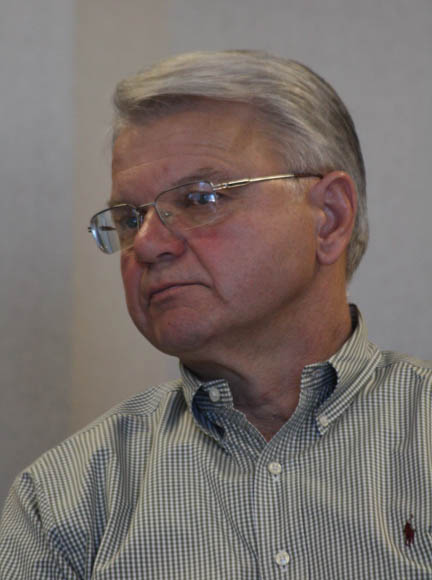 NOTE FROM THE BPWI RESEARCH NERD:
NOTE FROM THE BPWI RESEARCH NERD:
At Wind Siting Council meetings, member Bill Rakocy has been vocal about wanting as few restrictions on his wind development business as possible.
Questions have been raised about wind siting concil members with financial interest in the outcome of the rules having a direct hand in creating them.
“We’re excited to develop as much wind [power] as we can in Wisconsin,” says partner Bill Rakocy."
“The permitting process is a rather long-term effort,” says Rakocy. “A conditional use permit is good for two years, typically, and it may take you all of that two years to get the balance of the project details put in place. And then there’s production tax credits available from the federal government, and if they expire in the midst of the project, all your work is for naught.”
SOURCE: "Wind Power's Wind Fall" Marketplace Magazine <http://www.marketplacemagazine.com/content/357_1.php>
SECOND FEATURE

NOTE FROM THE BPWI RESEARCH NERD:
In an Wisconsin State Journal article [8/15/10] regarding new wind rules, reporter Clay Barbour refers to 'well-funded anti-wind organizations' in Wisconsin.
Better Plan contacted Barbour several times to ask about his source for this statement, but received no reply.
Balbour's article also contains quotes from Barnaby Dinges, who furthers the myth of the well-funded anti wind organization with statements like this:
“This isn’t like any grass-roots opposition we have seen elsewhere,” he said. “These aren’t just concerned citizens going to meetings. These are mass mailings, billboards, full-page ads. It’s more professional and it costs a lot of money.”
Dinges, who is not identified in the article as the head of an Illinois public relations firm called "The Dinges Gang", has been hired by wind developer Invenergy to push its projects in Wisconsin. Dinges Gang clients also include Abbott Laboratories, Illinois Casino Gaming Association, Montsanto and Jim Beam.
In the same article, Jennifer Heinzen, who is identified as a wind siting council member, says, “I have my suspicions that they are getting help from some groups from outside the state, but that has never been confirmed,” she said, referencing persistent rumors of coal and natural gas companies helping to kill wind projects here.
Balbour's article fails to mention Heinzen is also president of RENEW Wisconsin, an organization which lobbies on behalf of wind development and accepts funding from 'tera watt' business sponsors' such as Alliant Energy, American Transmission Company, and We Energies. Like the Dinges Gang, RENEW also receives money from wind giant, Invenergy.
Why Balbour's article failed to identify Dinges and Heinzen's financial ties to Invernergy, and other corporate clients is unknown.
So how do local groups identified in Balbour's article as 'anti-wind' raise money?
Better Plan received this a few days ago.
Perhaps Clay Balbour will write a follow up story about how things are really done on a grass roots level in our state: old-fashioned community fund raisers and a lot of hard work by local residents.

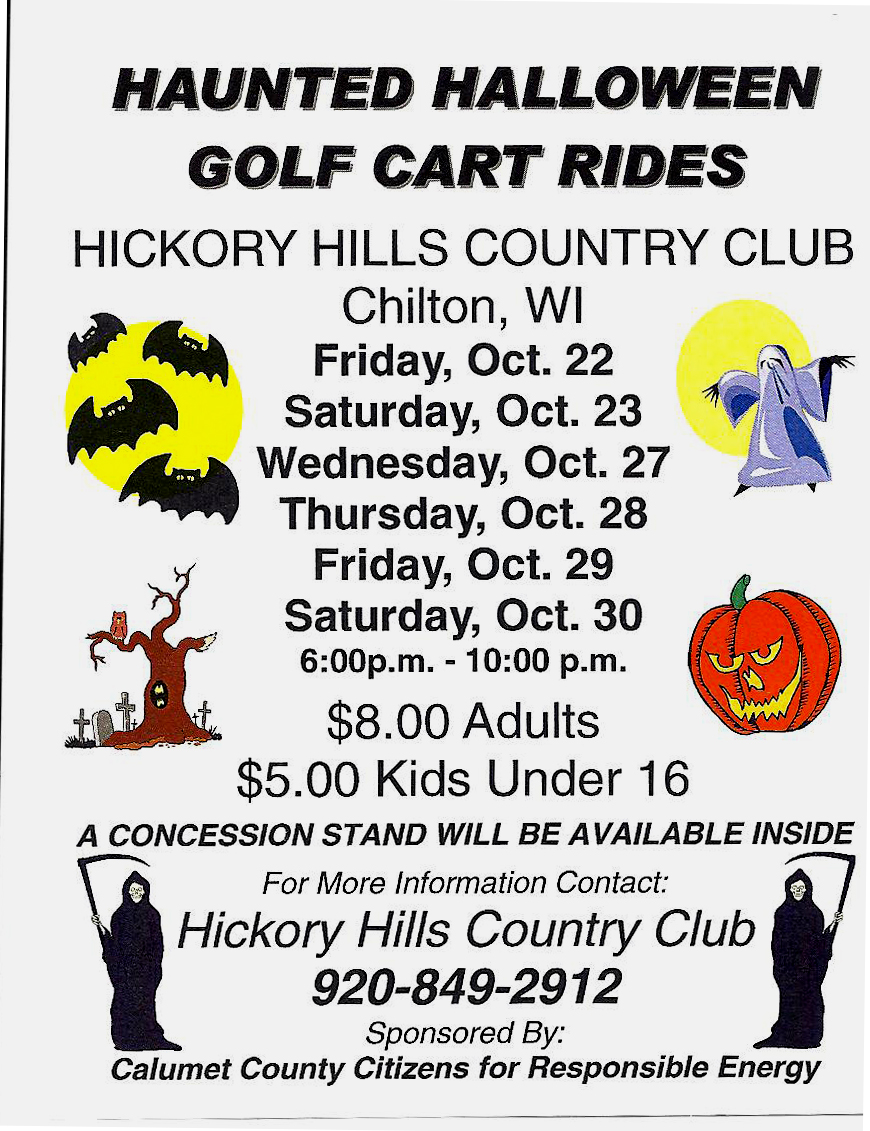
FROM THE CALUMET COUNTY CITIZENS FOR RESPONSIBLE ENERGY:
CCC4RE will be having our biggest fund raiser of the year in October: The Haunted Halloween Golf Cart Rides.
It's alot of work and many many people are involved to get this to work. Many volunteers will work all six nights and many work for days before getting it set up.
I'll be working all nights and will help set up on the 23rd. I work in the concession stand where we serve hot dogs, walking tacos, nachos, hot chocolate, apple cider and other goodies along with my husbands' outstanding chocolate chip cookies.
This helps to pay our bills. Let me know or if you have any other ideas.
Thanks,
Diane
Better Plan, Wisconsin hopes the event goes well and supports the true grass-roots efforts of the CCC4RE and all Badgers working to protect homes and families and wildlife and natural habitat from badly sited industrial scale wind turbines.
A bumper sticker we'd be glad to post on our car:
"I'd rather be riding a haunted golf cart in Calumet County in support of CCC4RE than living too close to a 500 foot wind turbine "
THIRD FEATURE
GOODHUE WIND SHRUGS OFF TOWNSHIP ORDER TO 'DESIST'
SOURCE: Finance & Commerce, finance-commerce.com
October 4, 2010
By Arundhati Parmar,
A proposed wind-energy project in southeastern Minnesota is pitting a local township’s board against the wind farm’s developers.
Last week, the Belle Creek Township board’s attorney sent a “cease and desist” letter to AWA Goodhue LLC, the developer of a 32,500-acre wind-turbine project in Goodhue County. The letter states that the developers have been doing construction work within the borders of the township in violation of an interim ordinance that the board approved earlier this summer.
On Friday, AWA Goodhue Wind’s attorney responded by essentially questioning whether the interim ordinance the board approved has any legal force under Minnesota law.
Minneapolis-based National Wind is the local developer of AWA Goodhue LLC, which is managing the project that aims to build 50 turbines. The Minnesota Public Utilities Commission (MPUC) and Goodhue County board of commissioners approved the project earlier this year, but it ran into opposition from residents who live near the 32,700-acre site
9/28/10 Should a community be clearly notified of a proposed wind farm? AND the High Cost of Free Wind
NOTE FROM THE BPWI RESEARCH NERD:
Why don't wind developers want to let a community know they are prospecting in their area?
In the video clip below, from a Wind Siting Council meeting in April, council member Larry Wunsch, who lives in the 86 turbine Invenergy project near the Town of Byron in Fond du Lac County explains why he would have liked clear notification that a project was planned for his area.
Andy Hesselbach, who is in charge of wind development for WeEnergies and a member of the Wind Siting Council explains why wind developers don't want a community to know their plans.
CUSTOMER GROUPS OPPOSE INCREASE
SOURCE: Journal Sentinel, www.jsonline.com
September 27, 2010
By Thomas Content
Clogged transmission lines will prevent green power generated by Wisconsin Power & Light Co.’s new Minnesota wind farm from reaching Wisconsin, so the Madison utility’s ratepayers shouldn’t have to pay higher prices linked to the nearly $500 million project.
That’s the argument presented to state energy regulators Monday by two customer groups that want to block a price increase from taking effect for WP&L customers on Jan. 1.
The customer groups say the Madison utility failed to disclose information about potential transmission problems that could prevent the Bent Tree Wind Farm project from generating as much power as the utility envisioned.
“Ratepayers should pay for only the goods they get, not the sales pitch they were given,” the Wisconsin Industrial Energy Group (WIEG) and Citizens’ Utility Board (CUB) said in a filing with the PSC on Monday.
But Wisconsin Power & Light said it has been transparent in providing information to regulators about the project and the status of securing enhanced transmission capacity to move the power from the wind farm in southern Minnesota to Wisconsin.
“CUB and WIEG’s allegations are unfounded and unsupported,” the utility said.
The utility said it expects transmission constraints to be resolved within a few years that would enable the project’s full output, 200 megawatts, to be able to flow onto the power grid.
At issue is WP&L’s proposal to raise rates by $18.9 million, or 1.9%, in January. The protests about the Bent Tree wind farm were raised by the same groups that filed suit last year seeking to overturn the state’s approval for the project.
A Dane County Circuit Court judge ruled last week that the Public Service Commission didn’t need to use a more exhaustive review process for Bent Tree. The wind farm is under construction, with turbines now being delivered to the site and erected, said utility spokesman Steve Schultz. The project is expected to open in phases beginning in November, with the entire project slated to be done by March, he added.
9/17/2010 When it comes to big wind projects, bats are in need of a super-hero-- National Geographic weighs in on what can be done to stop wind turbines from killing thousands of bats
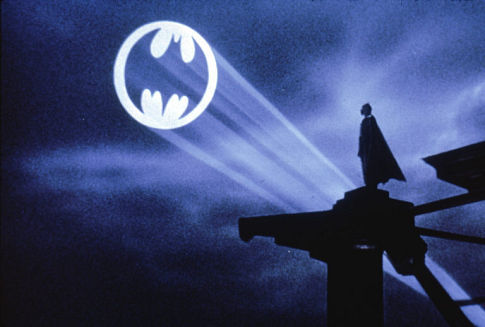
How many bats are dying in Wisconsin wind projects?
Three recent reports indicate the bat kill rates in Wisconsin wind projects are ten times the national average and the second highest in North America.
According to a recent post construction mortality report from We Energies the 88 turbines that make up the Blue Sky/ Green Field project have killed 7,000 bats during the first two years of operation.
Kill rates were the same in Dodge County's Cedar Ridge project and slightly higher in the Fond du lac County's Invenergy Forward project which is located alongside a national wildlife refuge.
Why Wisconsin bat mortality rates are so high in comparison to other parts of North America is unknown.
HOPE FOR STEMMING WIND ENERGY’S TOLL ON BATS
SOURCE: National Geographic News, news.nationalgeographic.com
September 15, 2010
By Andrew Curry,
Windmills—clean, quiet, simple and endlessly renewable—may be the ultimate icons of green energy. But after sundown, their whirling blades have an unintended consequence that researchers are just beginning to understand: They kill bats by the thousands.
Their greatest impact may be on the few species of bats that migrate. Bat experts say that the problem, which peaks during migration season from July to late September, may be worse than we know—but there’s cautious optimism, too. Proposed solutions include installing speakers that blast ultrasound to drive bats away and selectively shutting off windmills when bats are most active.
Killed by the Thousands
The first hint that wind farms were killing bats came from the Mountaineer Wind Energy Center on Backbone Mountain on the ridge of the Alleghenies near Thomas, West Virginia (map). Biologists looking for birds killed by the windmills in 2003 found nearly 400 dead hoary bats and eastern red-tailed bats. They soon concluded that the West Virginia site alone was killing between 1,400 and 4,000 bats a year.
In the years since, bat experts have raised the same alarm at other wind farms in the United States and Europe. Although there have also been concerns about windmills killing birds, the problem might be more severe for bats. For reasons no one fully understands, bat species that migrate over long distances seem to be attracted to the tall windmill towers. Perhaps they mistake them for trees, or want to hunt the insects that swarm around the tall, white structures. Maybe they’re simply curious.
When they fly too close, the nocturnal creatures are often killed by windmill blades, which, at the tips, can reach speeds of more than 200 mph. These massive wing-like blades strike some of the bats, while other bats are killed when they get sucked into the low-pressure zone behind the spinning blades. The low pressure can rupture bats’ tiny lungs and hearts.
As more and more wind energy installations are built, researchers are finding proportionately more dead bats. But one problem in gauging the full scope of the carnage is that researchers have almost no idea how many bats there are. Since they fly in the dark, it’s hard to count them the way that researchers count birds. Migratory bats tend to be solitary creatures, roosting in trees and crevices, so they can’t be counted easily when they’re asleep. And they’re too small—many weigh less than an ounce—to be tracked as birds sometimes are, with tags that can pinpoint their whereabouts through the use of GPS, or global positioning system.
“No one’s ever been able to actively track these bats. Before they started showing up under wind turbines, they were very infrequently observed,” says Paul Cryan, a bat expert working for the U.S. Geological Survey in Fort Collins, Colorado. “The logistics of following animals at night without knowing where they’re going and where they’re going to land is tremendously difficult.”
That uncertainty makes it difficult to tell what kind of impact windmills are having on the overall population—and how effective efforts to reduce the number of bat kills are. “We don’t know if we’ve mitigated the effect of the kills, or if we’re just delaying a population crash for 10 or 15 years,” says Ed Arnett, director of programs at Bat Conservation International in Austin, Texas. “But if you start adding it up over time, there’s just no way the animals can sustain this.”
Indeed, the many new wind projects across the United States—enough new windmills to power 2.4 million homes were installed last year—couldn’t have come at a worse time for bats.
Biologists are already overwhelmed trying to unravel a mysterious fungus known as white-nose syndrome that’s killing hundreds of thousands of cave-dwelling bats up and down the East Coast, with no cure in sight. “Those of us charged with the well-being of bats have really had the ground fall out from under us in the last 10 years,” Cryan says.
Renewable Energy Coexistence
But new research suggests that there may be hope on the horizon for protecting the migratory bats from windmill blades, at least. New methods for reducing bat kills are being tested in the field, and initial results are promising. One option is installing speaker systems on windmills to confuse and irritate bats with ultrasound noise, a frequency too high for human hearing. “It jams them, basically,” Arnett says. “We’re flooding them with white noise, which makes it uncomfortable and disorienting airspace to be in.”
So far, experimental speaker systems have reduced the number of bat fatalities 20 to 53 percent. But there are at least two problems with ultrasound systems, which cost $20,000 per experimental unit. First, modern windmill blades cover an area the length of a football field, too far to effectively project sound at that frequency. And the long-term consequences to bats and other wildlife of constant ultrasound are unclear.
Arnett has also experimented with an obvious solution: Turn off the windmills when bats are most active. For the past two years, Arnett has been working with Iberdrola Renewables, a large Spanish-owned wind energy provider, to selectively “feather,” or shut down, wind turbine at a wind farm in Garrett, Pennsylvania (map), when wind speeds are low. “It’s a time when we are not generating a whole lot of electricity to begin with,” says Iberdrola spokeswoman Jan Johnson.
In a forthcoming study, Arnett reports that during peak migration season, turning off windmills on the warm, late-summer nights bats like best—nights that don’t have that much wind to harness for energy, anyway—reduced annual bat fatalities by between 44 and 93 percent. Best of all, Arnett estimated that turning off windmills on the nights when bats were most active cost only .3 percent of the wind farm’s total annual power production. “We think there are ways to refine it so there are minimal impacts on the economics,” says John Anderson, siting policy director for the American Wind Energy Association.
The idea is gaining currency. Wind energy company Invenergy earlier this year agreed to time-of-year operating restrictions as part of a plan to protect the endangered migratory Indiana bat at a project it is now building in Greenbrier County, West Virginia. A federal judge temporarily blocked that project in response to a lawsuit by environmentalists; similar action over the risk to bats has been threatened over a new wind project in Maryland.
USGS bat expert Cryan says the Iberdrola study results are a relief to those who love the embattled bats. “Curtailment offers a great hope of minimizing bat fatalities,” he says. “Finally, this is something where we can come up with a solution to the problem.”
Note from the BPWI Research Nerd: The only reliable way to stop turbines from killing bats is to shut down the turbines at night.
10/14/10 On being a red square in a yellow circle: A wind siting council member weighs in on the real cost of Wisconsin wind farms AND Wind Turbines Too Loud? Sorry Charlie, ain't a lot we can do for you now.
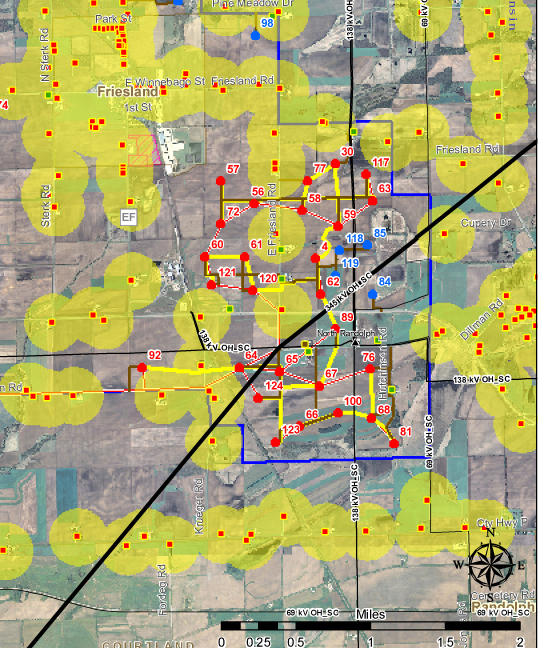
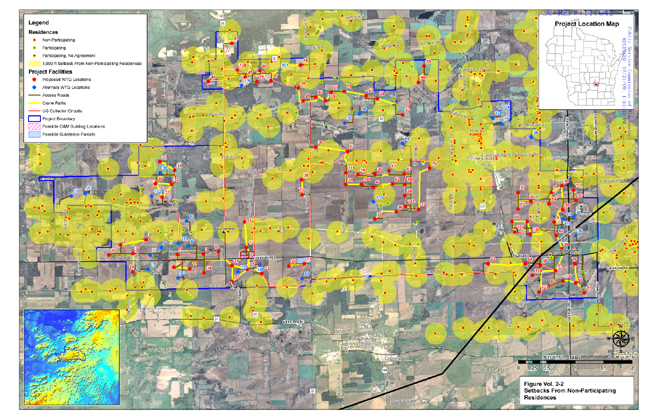
HOW MANY RESIDENTS WILL BE AFFECTED BY THE NEW WIND SITING RULES?
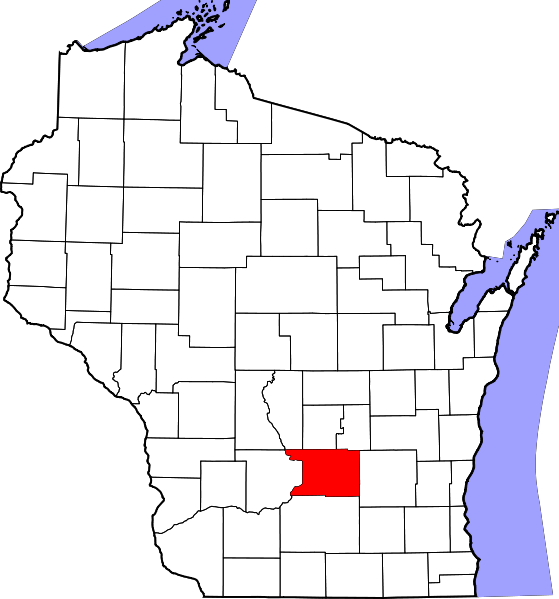
The red squares in the yellow circles on the map above represent non-participating homes in the WeEnergies Glacier Hills wind project currently under construction in Columbia County.
The larger red dots are the turbine locations. [Scroll down to see more detailed maps.]
The new wind rules adopted by the Public Service Commission have the same setbacks from homes as were used for this project.
One difference is the PSC required WeEnergies to offer to buy two homes in the project because seven turbines were to be located within half a mile.
The new rules do not include this sort of protection. Chairman Eric Callisto said by law homeowners have the right to sue the wind developer/owner and he felt that was all the protection they needed.
Although Wisconsin wind farm residents who have been forced to try to sell their homes because of turbine noise and shadow flicker have found no buyers, local wind developers say 400 to 500 foot tall wind turbines located less than 1500 feet a home have no impact on property values.
[CLICK HERE to watch Wisconsin Eye video: During the panel discussion, WPPI vice president Dan Ebert and WeEnergy's head of wind development Andy Hesselbach explain why turbines do not affect property value. ]
Or CLICK HERE to link directly to the Wisconsin Eye 'Newsmakers' feature "Future of Wind Energy"
Developers also say Wind energy is the cheapest way to get renewable energy and cite surveys which indicate stong public support for wind power.
Wind siting council member and Wisconsin realtor Tom Meyer weighs in on the matter.
This is not a question of whether or not people like, or favor "wind" as the lobbyists try to argue. Everyone likes wind, sun, water, earth.
The issue is this: The total cost of generating energy by the use of 400 and 500 foot tall turbines in Wisconsin’s rural communities.
Developers admit that they cannot get investors, who are primarily foreign investors, to put their money up unless the costs of access to the land are depressed.
To get the biggest area to install the highest number of 400 to 500 foot tall turbines, the developer needs to have the greatest access to the most land and compensate the fewest people with the least dollars.
The developer does not need your land, he needs to get one foot [away] from your land.
Every foot the developer is made to move away from a landowner whom he does not have to compensate, adds cost to the developer and reduces the bottom line to investors.
Every dollar spent to gain access to the right to disturbing the peace of a landowner reduces the bottom line.
For wind turbines to be profitable, the industry could improve the technology or depress the cost of access to the land.
By their actions, they prove they believe depressing land costs is more favorable than investing in improving the technology.
Their answer to improved technology is taller and more intrusive. That's not a real solution.
If the turbine can't produce energy without imposing on neighbors, there is no reason to spoil the earth, and threaten the water, and block the sun, to catch the wind.
-Tom Meyer
Wisconsin Wind Siting Council Member
NOTE: Tom Meyer was one of the authors of the minority report from the wind siting council. The report details why some council members strongly disagree with the recommendations sent forth to the Public Service Commission.
CLICK HERE to download pictures of homes in Wisconsin wind projects.
Below, detail maps of non-participating residences in WeEnergies Glacier Hills Project
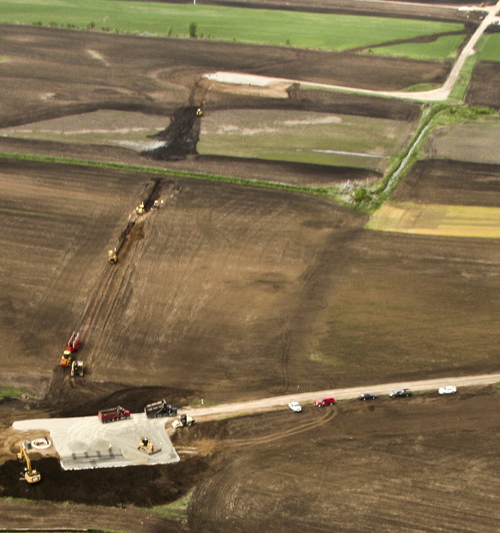
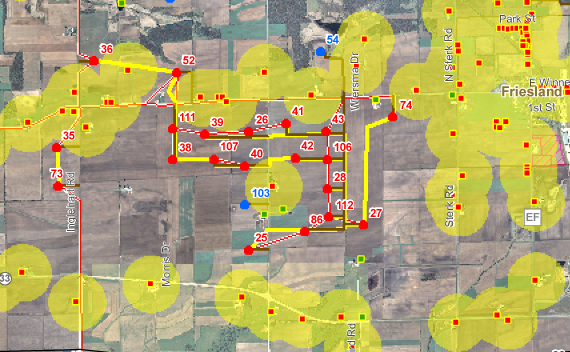
NOTE FROM THE BPWI RESEARCH NERD:
The project mentioned below was sited with the same setbacks and noise limits used to site the We Energies Glacier Hills project. (Detail maps above)
NO EASY SOLUTION TO WIND TURBINE PROBLEM
The Associated Press
VINALHAVEN, Maine (AP) -- The CEO of the electric cooperative that installed wind turbines on Maine's Vinalhaven island says there's disagreement over data suggesting they're too noisy.
Fox Island Wind CEO George Baker says his experts dispute the findings of a Department of Environmental Protection consultant who says the turbines violate nighttime noise limits.
State law sets a 45-decibel limit. Baker says his experts believe it was ambient noise from wind rustling through trees that exceeded 45 decibels, not the turbines themselves.
Baker says it'll be a difficult issue to resolve. He told The Associated Press on Tuesday that slowing the turbine blades to lower the noise level by a couple of decibels may not make appease critics. And lowering it further could hurt the economic viability of the project.

